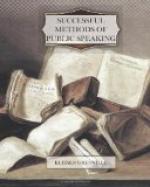John Bright, the eminent British orator, always required time for preparation. He read every morning from the Bible, from which he drew rich material for argument and illustration. A remarkable thing about him was that he spoke seldom.
Phillips Brooks was an ideal speaker, combining simplicity and sympathy in large degree. He was a splendid type of pulpit orator produced by broad spiritual culture.
Henry Ward Beecher had unique powers as a dramatic and eloquent speaker. In his youth he hesitated in his speech, which led him to study elocution. He himself tells of how he went to the woods daily to practise vocal exercises.
He was an exponent of thorough preparation, never speaking upon a subject until he had made it his own by diligent study. Like Phillips Brooks, he was a man of large sympathy and imagination—two faculties indispensable to persuasive eloquence.
It was his oratory that first brought fame to Gladstone. He had a superb voice, and he possest that fighting force essential to a great public debater. When he quitted the House of Commons in his eighty-fifth year his powers of eloquence were practically unimpaired.
Wendell Phillips was distinguished for his personality, conversational style, and thrilling voice. He had a wonderful vocabulary, and a personal magnetism which won men instantly to him. It is said that he relied principally upon the power of truth to make his speaking eloquent. He, too, was an untiring student of the speaker’s art.
As we examine the lives and records of eminent speakers of other days, we are imprest with the fact that they were sincere and earnest students of the art in which they ultimately excelled.
LEARNING TO THINK ON YOUR FEET
One of the best exercises for learning to think and speak on the feet is to practise daily giving one minute impromptu talks upon chosen subjects. A good plan is to write subjects of a general character, on say fifty or more cards, and then to speak on each subject as it is chosen.
This simple exercise will rapidly develop facility of thought and expression and give greatly increased self-confidence.
It is a good plan to prepare more material than one intends to use—at least twice as much. It gives a comfortable feeling of security when one stands before an audience, to know that if some of the prepared matter evades his memory, he still has ample material at his ready service.
There is no more interesting and valuable study than that of speaking in public. It confers distinct advantages by way of improved health, through special exercise in deep breathing and voice culture; by way of stimulated thought and expression; and by an increase of self-confidence and personal power.
Men and women in constantly increasing numbers are realizing the importance of public speaking, and as questions multiply for debate and solution the need for this training will be still more widely appreciated, so that a practical knowledge of public speaking will in time be considered indispensable to a well-rounded education.




